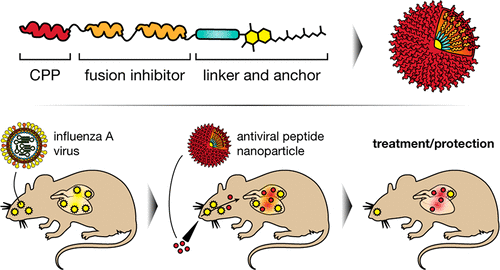当前位置:
X-MOL 学术
›
Bioconjugate Chem.
›
论文详情
Our official English website, www.x-mol.net, welcomes your
feedback! (Note: you will need to create a separate account there.)
Effective in Vivo Targeting of Influenza Virus through a Cell-Penetrating/Fusion Inhibitor Tandem Peptide Anchored to the Plasma Membrane
Bioconjugate Chemistry ( IF 4.0 ) Pub Date : 2018-08-31 00:00:00 , DOI: 10.1021/acs.bioconjchem.8b00527 T. N. Figueira 1, 2, 3 , M. T. Augusto 1, 2, 3 , K. Rybkina 2 , D. Stelitano 2 , M. G. Noval 2 , O. E. Harder 4 , A. S. Veiga 1 , D. Huey 4 , C. A. Alabi 5 , S. Biswas 2, 3 , S. Niewiesk 4 , A. Moscona 2, 3, 6, 7 , N. C. Santos 1 , M. A. R. B. Castanho 1 , M. Porotto 2, 3, 8
Bioconjugate Chemistry ( IF 4.0 ) Pub Date : 2018-08-31 00:00:00 , DOI: 10.1021/acs.bioconjchem.8b00527 T. N. Figueira 1, 2, 3 , M. T. Augusto 1, 2, 3 , K. Rybkina 2 , D. Stelitano 2 , M. G. Noval 2 , O. E. Harder 4 , A. S. Veiga 1 , D. Huey 4 , C. A. Alabi 5 , S. Biswas 2, 3 , S. Niewiesk 4 , A. Moscona 2, 3, 6, 7 , N. C. Santos 1 , M. A. R. B. Castanho 1 , M. Porotto 2, 3, 8
Affiliation

|
The impact of influenza virus infection is felt each year on a global scale when approximately 5–10% of adults and 20–30% of children globally are infected. While vaccination is the primary strategy for influenza prevention, there are a number of likely scenarios for which vaccination is inadequate, making the development of effective antiviral agents of utmost importance. Anti-influenza treatments with innovative mechanisms of action are critical in the face of emerging viral resistance to the existing drugs. These new antiviral agents are urgently needed to address future epidemic (or pandemic) influenza and are critical for the immune-compromised cohort who cannot be vaccinated. We have previously shown that lipid tagged peptides derived from the C-terminal region of influenza hemagglutinin (HA) were effective influenza fusion inhibitors. In this study, we modified the influenza fusion inhibitors by adding a cell penetrating peptide sequence to promote intracellular targeting. These fusion-inhibiting peptides self-assemble into ∼15–30 nm nanoparticles (NPs), target relevant infectious tissues in vivo, and reduce viral infectivity upon interaction with the cell membrane. Overall, our data show that the CPP and the lipid moiety are both required for efficient biodistribution, fusion inhibition, and efficacy in vivo.
中文翻译:

有效体内通过细胞穿透/融合抑制剂串联肽锚靶向流感病毒至质膜
在全球范围内,每年大约有5-10%的成年人和20-30%的儿童受到流感病毒感染的影响在全球范围内受到影响。尽管疫苗接种是预防流感的主要策略,但在许多可能的情况下,疫苗接种不足,因此开发有效的抗病毒药物至关重要。面对新出现的对现有药物的病毒耐药性,具有创新作用机制的抗流感治疗至关重要。迫切需要这些新的抗病毒药物来应对未来的流行(或大流行)流感,并且对于无法接种疫苗的免疫功能低下的人群至关重要。先前我们已经表明,源自流感血凝素(HA)C端区域的脂质标记肽是有效的流感融合抑制剂。在这项研究中,我们通过添加细胞穿透肽序列以促进细胞内靶向来修饰流感融合抑制剂。这些抑制融合的肽可自组装成约15–30 nm的纳米颗粒(NPs),靶向相关的感染组织体内,并且在与细胞膜相互作用降低病毒感染性。总体而言,我们的数据表明CPP和脂质部分都是有效的生物分布,融合抑制和体内功效所必需的。
更新日期:2018-08-31
中文翻译:

有效体内通过细胞穿透/融合抑制剂串联肽锚靶向流感病毒至质膜
在全球范围内,每年大约有5-10%的成年人和20-30%的儿童受到流感病毒感染的影响在全球范围内受到影响。尽管疫苗接种是预防流感的主要策略,但在许多可能的情况下,疫苗接种不足,因此开发有效的抗病毒药物至关重要。面对新出现的对现有药物的病毒耐药性,具有创新作用机制的抗流感治疗至关重要。迫切需要这些新的抗病毒药物来应对未来的流行(或大流行)流感,并且对于无法接种疫苗的免疫功能低下的人群至关重要。先前我们已经表明,源自流感血凝素(HA)C端区域的脂质标记肽是有效的流感融合抑制剂。在这项研究中,我们通过添加细胞穿透肽序列以促进细胞内靶向来修饰流感融合抑制剂。这些抑制融合的肽可自组装成约15–30 nm的纳米颗粒(NPs),靶向相关的感染组织体内,并且在与细胞膜相互作用降低病毒感染性。总体而言,我们的数据表明CPP和脂质部分都是有效的生物分布,融合抑制和体内功效所必需的。





















































 京公网安备 11010802027423号
京公网安备 11010802027423号